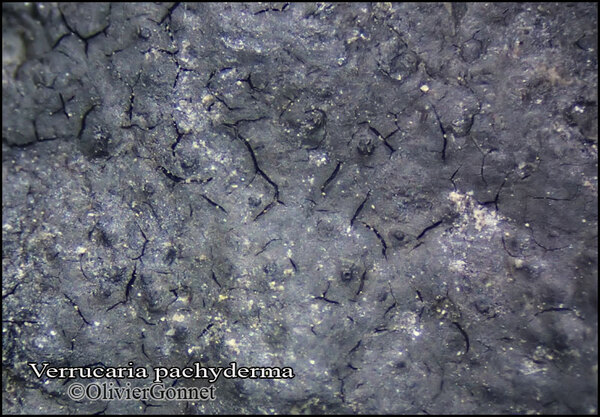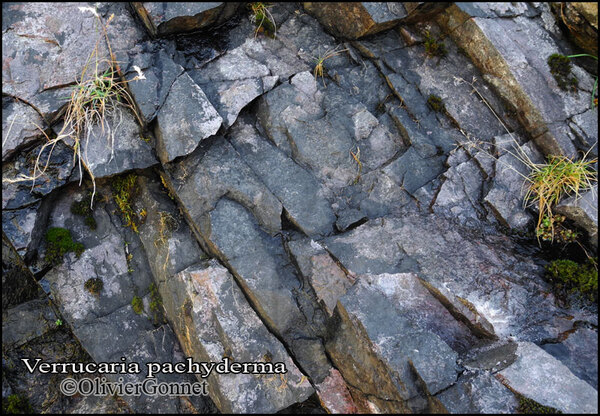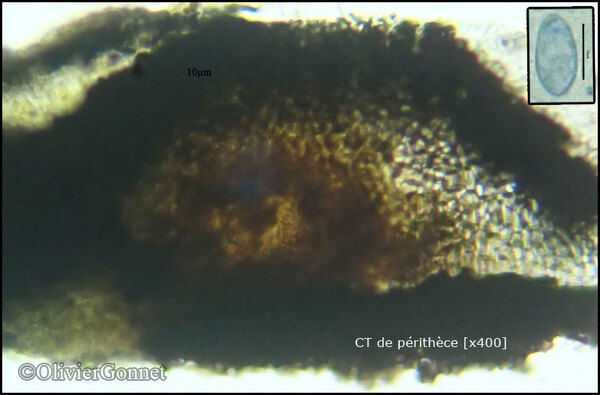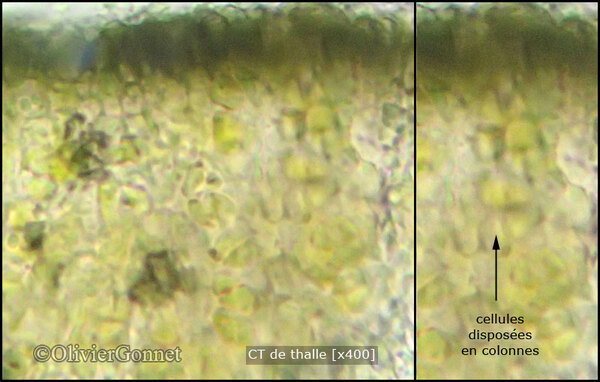Verrucaria pachyderma Arnold
Verh. zool.-bot. Ges. Wien, 30: 146, 1880.
Synonyms: Verrucaria pissina Nyl.
Distribution: N - TAA (Nascimbene & al. 2022).
Description: Thallus crustose, episubstratic, subgelatinous when wet, mostly continuous, 40-200 μm thick, smooth, dull or slightly glossy, dark grey-green to blackish, sometimes with a brownish tinge, rarely delimited by a thin dark prothallus. Cortex weakly defined, with a dull green to brown-black pigment (lacking in shade-forms); algal layer paraplectenchymatous, 50-80 μm thick; medulla poorly developed, with oil cells and sometimes with a dilute brown pigment, but without a black basal layer. Perithecia immersed in thallus, not or only slightly projecting, the apex visible as a grey to black dot or ring. Involucrellum reddish brown and K+ grey, from thin and adpressed to apex of exciple to conical and spreading, sometimes reaching base-level and laterally spreading, but rarely forming a black basal layer; exciple 0.16-0.2(-0.35) mm across, the wall colourless except around the ostiole; hamathecium of up to 20 μm long periphyses and periphysoids, interascal filaments absent; hymenial gel hemiamyloid, I+ red (I+ blue at very low concentrations of I), K/I+ blue. Asci 8-spored, clavate, I-, fissitunicate, the wall thickened above, with an ocular chamber, dehiscent by extrusion of an endotunica to form a delicate rostrum, Verrucaria-type. Ascospores 1-celled, hyaline, ellipsoid to oblong-ellipsoid, (15-)17-22(-23.5) x 6-8(-9) μm, with a thin gelatinous perispore best visible in fresh material. Photobiont chlorococcoid, the cells arranged in vertical columns. Spot tests: K-, C-, KC-, P-, UV-. Chemistry: without lichen substances.
Note: a freshwater species of periodically submerged siliceous rocks in upland areas, also known from the British Isles, Scandinavia, and the Austrian and Swiss Alps. For further details see Orange (2013b).
Growth form: Crustose
Substrata: rocks
Photobiont: green algae other than Trentepohlia
Reproductive strategy: mainly sexual
Periodically submerged (e.g. in creeks)
Commonnes-rarity: (info)
Alpine belt: extremely rare
Subalpine belt: very rare
Oromediterranean belt: absent
Montane belt: very rare
Submediterranean belt: absent
Padanian area: absent
Humid submediterranean belt: absent
Humid mediterranean belt: absent
Dry mediterranean belt: absent

Predictive model
Herbarium samples

Courtesy Danièle et Olivier Gonnet - Source: https://www.afl-lichenologie.fr/Photos_AFL/Photos_AFL_V/Texte_V/Verrucaria_pachyderma.htm
France, 24/11/2011 - Asco, sous le lac d’Argent, alt. 2100 m - Corse

Courtesy Danièle et Olivier Gonnet - Source: https://www.afl-lichenologie.fr/Photos_AFL/Photos_AFL_V/Texte_V/Verrucaria_pachyderma.htm
France, 24/11/2011 - Asco, sous le lac d’Argent, alt. 2100 m - Corse

Courtesy Danièle et Olivier Gonnet - Source: https://www.afl-lichenologie.fr/Photos_AFL/Photos_AFL_V/Texte_V/Verrucaria_pachyderma.htm
France, 24/11/2011 - Asco, sous le lac d’Argent, alt. 2100 m - Corse
Growth form: Crustose
Substrata: rocks
Photobiont: green algae other than Trentepohlia
Reproductive strategy: mainly sexual
Periodically submerged (e.g. in creeks)
Commonnes-rarity: (info)
Alpine belt: extremely rare
Subalpine belt: very rare
Oromediterranean belt: absent
Montane belt: very rare
Submediterranean belt: absent
Padanian area: absent
Humid submediterranean belt: absent
Humid mediterranean belt: absent
Dry mediterranean belt: absent

Predictive model
| Herbarium samples |

Courtesy Danièle et Olivier Gonnet - Source: https://www.afl-lichenologie.fr/Photos_AFL/Photos_AFL_V/Texte_V/Verrucaria_pachyderma.htm
France, 24/11/2011 - Asco, sous le lac d’Argent, alt. 2100 m - Corse

Courtesy Danièle et Olivier Gonnet - Source: https://www.afl-lichenologie.fr/Photos_AFL/Photos_AFL_V/Texte_V/Verrucaria_pachyderma.htm
France, 24/11/2011 - Asco, sous le lac d’Argent, alt. 2100 m - Corse

 Index Fungorum
Index Fungorum
 GBIF
GBIF



